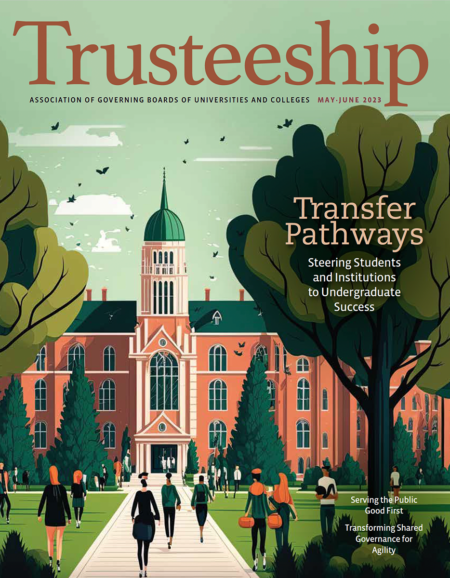
The value proposition of public higher education is one of the crucial challenges of our time. Is the cost of a degree worth it? Will my child have a job after college? What has my state’s university system done for me lately?
The questions are apt and, for as long as I can remember, we’ve given the same answers to these questions. Advocates of higher education—including the Association of Governing Boards
of Universities and Colleges—have spoken about this issue in consistent terms. We highlight the myriad societal benefits of an educated public, extol the economic impacts of university-led research, and count the ways in which educated and employable college graduates benefit from their degrees.
All of these benefits are true. But it is time to think anew about how we answer these questions. How can we leverage the public good of universities in a way that increases trust in public higher education and restores the value proposition? In Arizona, we are answering this question in a unique and impactful way.
How can we leverage the public good of universities in a way that increases trust in public higher education and restores the value proposition? In Arizona, we are answering this question in a unique and impactful way.
The Starbucks Test
Champions of higher education must draw a clearer line between the tax dollars these institutions spend and the benefits they bring to students, families, and the tax-paying public. This is true in every part of what universities do.
Consider research spending. The lion’s share of university research results from, and is responsive to, the desires of the funder—whether government, philanthropic, or private. In 2000, Arizona became a direct funder and research client of our universities. Arizona voters approved a ballot measure, Proposition 301, that raised the sales tax to generate revenue for workforce programs and education. A small portion—three-tenths of a cent—was earmarked for university research.
For the first 20 years, the research followed the established playbook and was conducted in a manner aligning with existing and aspirational university strengths. We decided ourselves what the research funding priorities would be.
I would often remind our university and research team leaders that this research funding source was distinctly public and directly taxpayer subsidized. And I would ask, “what is the public ROI?”
I formulated what I called the Starbucks Test: In the time it takes to get your morning coffee, could you explain to the customer standing next to you in line what the sales tax he or she just paid is funding and make a case for why they should care?
As a result of this dialogue, two years ago the Arizona Board of Regents—which governs our state’s three public universities—pioneered a novel approach to university research: Regents’ Research Grants.
A New Way to Think About University Research
The idea was to start with the taxpayer as beneficiary. We earmarked a small portion of Proposition 301 tax revenue to fund targeted research with the greatest tangible—and easily explainable—impact on the lives of Arizonans. We approached then Governor Doug Ducey with a proposition: What if Arizona public universities were thought of as a state-operated think tank? What problems would you ask us to solve?
The governor convened an inter-agency task force to solicit ideas from state agencies and to prioritize these projects. The Board of Regents then culled these proposals down to a handful, which we put in front of our universities to assess their talent and capacity to tackle them. Arizona has three large research universities, and a multi-university approach was utilized whenever possible to leverage the combined talent and resources of the institutions.
We distributed five grants, called Regents’ Research Grants, in 2021 and seven more in 2022, with each project funded for two to three years. In each case, Arizona universities partnered with a host state or federal agency or association to address a longstanding challenge. It could be almost anything—environmental, public health, the economy, and more. The primary requirement was that every Regents’ Research Grant had to fund research with the broadest possible public impact and benefit.
Some of the results?
- We’re addressing the problem of bark beetles in Arizona forests that kill trees and render them highly flammable tinder for wildfires. Researchers are determining how to monitor and eradicate the beetle by deploying acoustic and sonar technology to drive away insects while tracking overall tree health.
- We are helping to mitigate certain line-of-duty-related cancers in firefighters. Firefighters have a 14 percent higher cancer death rate than the general population, caused in part by so-called “forever chemicals”—substances found in their protective clothing and in the fire suppressing foam they use. Our universities are now working with local fire chiefs across Arizona to conduct a 1,500-person study of new approaches to mitigate cancer risks in firefighters exposed to these harmful chemicals.
- The water shortage in Arizona and across the southwest is well known, and the crisis of declining groundwater supplies is particularly acute. Regents’ Research Grants are funding a collaborative effort between the state water department and localities that utilizes mapping and modeling technology to determine how to more effectively capture and channel excess moisture—such as from this winter’s bountiful rains and mountain snowfall—to recharge aquifers.
- Arizona’s smaller towns have lost the ability to operate recycling programs as the Chinese market for these products has shut down. University research identified the need for a spoke-and-wheel strategy that coordinates activities and creates a collective approach to recycling that will get to scale—and help bring these materials to market. Our universities are doing this work in partnership with Arizona cities and towns
- Valley Fever is a sometimes-deadly respiratory disease that strikes thousands of Arizonans annually and is caused by coccidioidomycosis, a fungus that lives in the desert soil in our state and other parts of the Southwest. Researchers from each of our state’s public universities have combined efforts across multiple scientific disciplines—chemical, atmospheric, and more—to better understand Valley Fever transmission and propose steps to mitigate risk to public health. This includes study of a potential spray to help harden desert soil and make the spores inside less susceptible to becoming airborne during storms and strong winds.
These are just a handful of examples of Regents’ Research Grants. It is research that passes the Starbucks test.
Getting Results
Across all revenue lines, there is over $1.6 billion in important research taking place at Arizona’s public universities. Regents’ Research Grants account for merely about $25 million of that. But what is significant here is the reverse engineering: Start with the taxpayer.
The proof point in this approach is the amount of media attention these grants have received—many dozens of news stories across all media platforms. In the public media, these approximate $25 million of grants (less than 1% of total research expenditures at the universities during fiscal years 2021 and 2022) generated significant and wide-ranging news coverage throughout the state of Arizona.
And it has directly leveraged our intellectual capital into political capital.
In a tweet, Ducey shared he was, “excited to see the launch of the Regents’ Grants, which will help drive innovation, strengthen research and uncover new solutions,” citing the grants as a great example of collaboration between the state and the universities.
“This grant and the research it will fund are beacons of hope for our firefighters,” said Tom Shannon, Arizona Fire Chiefs Association president and Scottsdale Fire Department chief, regarding the grant to reduce cancer in firefighters. “Our great hope is that it will improve life outcomes for our firefighters.”
“Combining the practical problem solving of state agencies and the robust research resources of the state’s universities in my opinion is no less than brilliant,” said Arizona Department of Environmental Quality Director Misael Cabrera of the grant to unlock solutions to Valley Fever. “It couples the practical with the possible and reminds us that policy is often best informed through rigorous research and applied science to solve our most pressing problems.”
Obviously, these are helpful allies in seeking public appropriations from the state legislature. Our universities’ narrative is moving from private benefits to public benefits.
This approach has been such a success that we have decided to replicate it in the form of Regents’ Community Grants and are seeking funding requests from local officials. An initial grant, awarded this March, will help local police and fire departments identify solutions to critical staffing shortages among first responders. It was requested by mayors and county elected officials from around the state.
In coming years we look forward to year-round engagement from both state and local officials coming to us for help and for solutions to the public issues they face. Making presentations of our work to their public meetings. Asking them to join us for our annual budget requests at the legislature.
An appropriations hearing that positions police chiefs, firefighters, and local elected officials next to our university presidents at the dais, is a very different look.
At a time when the public and policymakers too often doubt the value of research universities, or deem our work irrelevant to the average taxpayer, this new approach to research has knitted our partnership with the state to collaborate on driving solutions to our most pressing issues.
That is the new value proposition of Arizona’s public universities.
Fred DuVal is chair-elect of the Arizona Board of Regents, which governs Arizona State University, Northern Arizona University, and the University of Arizona, and is a former director of AGB. Earlier, DuVal served as President Bill Clinton’s deputy assistant to the president for intergovernmental affairs and was a senior aide to Arizona Governor Bruce Babbitt (1980–85). As a regent, he originated the Arizona Teachers Academy, founded the Institute for Civil Discourse at the University of Arizona and pioneered AZTransfer.com, a seamless transfer portal for college credits.
RELATED RESOURCES

Tools and Toolkits
Board Responsibility for Equitable Student Success

Reports and Statements
Collaborative Leadership for Higher Education Business Model Vitality

